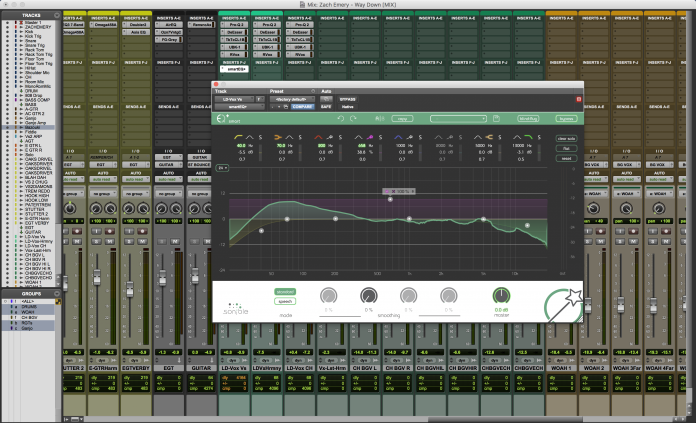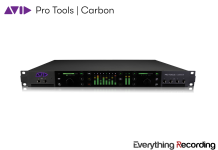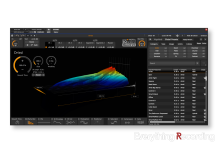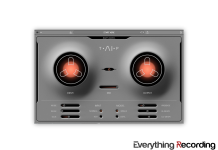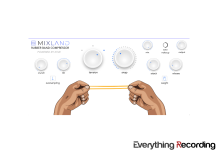We’ve all been here. A track presents itself with problematic frequencies and resonances but no matter how much tweaking is done, just won’t fit in a mix. Maybe you’re a professional in a fast-paced audio environment who needs precision on the go. Maybe you’re new to the mixing game and need a little help learning what to look for when EQing tracks. Or… maybe you’re just a lazy engineer. There’s no shame in any of that; Sonible Smart:EQ+ has you covered. This EQ uses intelligent algorithms in its “smart” bands to analyze the content of tracks and suggests an EQ curve, more precise and accurate than conventional EQ.
The plugin comes in all of the standard VST, AU, and AAX flavors and installation is a breeze. Registration comes via a computer bound license model and can only be installed on two systems. This can be problematic for engineers on the go due to not being able to store the license on USB thumb drives or iLoks but registration is fairly quick and easy. Note: I hear iLok is coming in the near future. A trial can be utilized for 30 days with no limitations as well. Another incredible fact that I hope EVERY plugin company sees rests in the bottom right corner of the GUI. If an update is available for the plugin, the area with the magic wand will display that a new version is available. For every engineer, this is beyond valuable given the sheer amount of plugins most have in their DAW. I can’t stress enough how genius this feature is.
At its core, Smart:EQ+ is an 8 band linear phase EQ with adjustable “Q” and fully sweep-able filters. The high and low pass filters as well as the shelving bands can also be toggled to bell filters if more are needed on a track. The interface is very straight-forward and can even be placed in “blind:flug” mode whereby all graphics are disabled and the user can depend on their ears to make key decisions. In order to make learning their plugin easier, hovering over a feature will pop up a brief description of the use of the feature. Each of the 8 bands have all of the trappings of most EQs with sweep-able frequency, gain, solo and Q, but there are a few other tricks Smart:EQ+ has under its sleeve.
To the right of the bands are three buttons stacked on each other. The Clear Solo will remove the solo feature from all bands for quick reference to the whole picture. Flat will return all gains but will leave all other settings intact and Reset will default the whole plugin. The visuals on the interface are great and the layout is superb. Each band has a representative color and Q values and gain can be seen very quickly when making adjustments using the color coded system. Overall even just as EQ plugins go, Smart:EQ+ is right up there at the top as far as function and presentation, but what sets it apart rests in the “magic wand” icon.
Smart Mode sits proudly in the middle four bands and serves a very useful and unique purpose. When the wand is clicked between the filter and solo buttons, a menu will pop up on the node of the band, waiting for audio to be played in order to analyze the frequency content and create a custom EQ curve. This curve is created to balance deficiencies and bring out what the algorithm sees best for the track. All that needs to be done on the user’s end is to pick either Speech (for vocal tracks) or Standard for everything else and a section of the track that has minimal silence and press the wand on a band. The wand will flash and will listen for audio for 15 seconds to analyze the frequency content. Once analyzing is complete, a check box will appear on the node of the band in which Smart mode was selected. Once Smart Mode is active, the gain behaves like a quasi-wet/dry knob where the more gain is applied, the more of Smart Mode’s EQ curve is applied. The gain can even be applied backwards to take out what Smart Mode suggested. The Q knob now controls how wide the EQ curve spans. P.S. Don’t worry about reanalyzing the band if you want Smart Mode to span more or less of the frequency spectrum. When a band is analyzed, it analyzes the entire spectrum every time. The only time Smart Mode would need reanalyzing is if the section analyzed didn’t affect the audio in a way the user saw as beneficial. Multiple bands in multiple areas can employ smart mode to only affect small pockets or one band can open the Q to 0 to give an EQ curve for the whole signal. Just note: if spanning the entire frequency spectrum, higher frequency content may behave a little erratically (past 15kHz) so care must be taken to dial the Q to compensate. On top of the basic controls of smart mode, a global “Smooth” control at the bottom will apply a broader, more natural curve to Smart Mode as well. This is used more to create a slightly more subtle impact.
So the interface is easy to use, versatile, and aesthetically pleasing. The update notification in the GUI is one of the most genius, useful things I’ve seen a plugin company do in ages. I also had no trouble learning smart mode and putting it to use. The Clear Solo, Flat, and Reset buttons were useful, but I would have loved to see them offer a “kick” mode similar to Eiosis AirEQ where “alt” or “shift” would allow for all solos or flat bands to be used quicky but still retain original settings. How I use this on AirEQ is I EQ the signal as I see fit and hold “alt” to quickly bypass my settings without having to press “bypass” two times. This would really pair great with Smart Mode to compare settings and speed up workflow.
So let’s get down to the question everyone is asking. How does the Smart Mode perform? On single tracks, like vocals in Speech mode, Smart:EQ+ performed very well, in almost all cases adding a pleasing balance to just about any track I threw at it, even not-so-greatly recorded vocals. I did find that parts with more dynamics like the chorus worked a little better than the verses to use for Smart Mode analysis. I attribute this to the principle that the more you give it spectrally, the more you get out of it. In songs with a bridge or slightly energetic second verse worked good for an overall baseline. Standard mode yielded very similar results that Speech mode with vocals as well but Standard really did shine with individual tracks. Instrument tracks saw a good benefit from Smart Mode as well, adding more fullness in guitars and removing resonances in snares. As a plugin on individual tracks, I say Smart:EQ+ is worth its weight in gold not only for the every day mix, but also for the budding engineer or professional on the go. This plugin does help shave off precious time on mixes no doubt. It’s almost like autopilot on EQ.
Some of the areas Smart Mode didn’t fare so well was on bus tracks and the master fader. When a great deal of frequency content is handed its way, it tends to not work as well. Don’t get me wrong, it still analyzes and suggests, but a lot more effort on the user’s part is needed to find the perfect spot to analyze. This isn’t necessarily Smart:EQ’s fault. Think about it – every part of a song has different instruments moving in and out and 30 seconds is a tough gauge for an entire song. What almost needs to happen is a “live” streaming mode where the EQ is making adjustments on the fly. This however would be pretty tough to accomplish in the grand scheme of things for a plugin manufacturer. Sonible is definitely headed down the correct path for this in the future but for now, we have a plugin that still performs and impressive feat.
Overall, I love the plugin. The combination of Smart Mode and adding bands to fill in the gaps the algorithm doesn’t detect seems to be a perfect pairing. If you go as far as have a little patience and a love for automation, the plugin could even analyze each section of a song to give you a slightly more dynamic form of Smart Mode. Ultimately, this plugin is staying in the front of the pack as far as my arsenal is concerned. I’m really excited to see Sonible push this innovative concept further in the future. Bravo!
For more information, and to purchase, visit http://www.sonible.com/smarteq/



